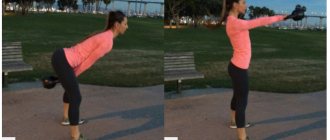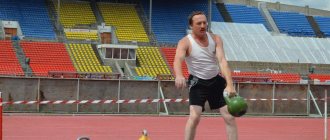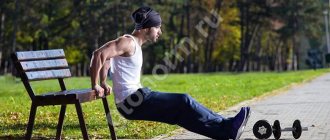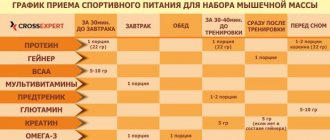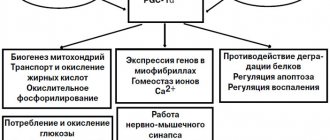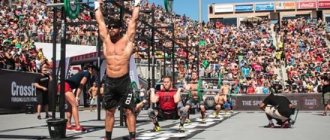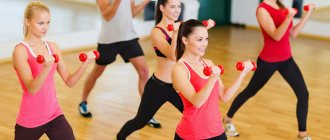List of mistakes when working with weights. What is critical, and what do professional “strongmen” consider to be features of technology? Read the article and try our kettlebell workout without mistakes!
Kettlebells are a truly Russian sport (today: a type of weightlifting), which develops strength and trains endurance. In addition to the heroic strength of kettlebell lifting, the exercises of which involve all muscle groups, you will get pumped up pectoral muscles, biceps, back, legs, shoulders and even abs.
Until the late 40s of the 20th century, kettlebell lifting in the modern sense, as a competition in strength endurance, did not exist. Although the weights themselves as sports equipment have been known since the end of the 17th century. Kettlebells, along with barbells and dumbbells, were used to develop physical strength or in circus performances.
Training in kettlebell lifting cannot be called technically complex: the mechanics can be mastered in just 1-2 lessons, however, many mistakes are made when performing the exercises. Next, we will tell you which of them are critical and can affect the results of your training. Study and train correctly.
What is kettlebell lifting
A sport in which athletes perform vertical lifting of weights for a while. Lifting weights requires strength, endurance and special exercise technique. There are the following disciplines for men and one for women:
Men participate in classic combined events and long cycle clean and jerk. The double event consists of two exercises: a standing push of two kettlebells with both hands from the chest and a standing snatch of one kettlebell with each hand.
Two-handed kettlebell push
One-arm kettlebell snatch
In the snatch exercise, one change of hands is allowed without placing the weight on the platform. After the athletes have completed their performances in two exercises, the judges count the points in the total of the entire double event.
The “long cycle push” exercise differs from a regular push in that the athlete, after lifting two weights with both hands, drops the weights to his feet and, without placing them on the platform, throws them back onto his chest.
Long cycle kettlebell push
Story
The kettlebell as a sports equipment has been used since ancient times to develop strength and endurance, to prepare soldiers for military action and Greek athletes for the Olympic Games. Kettlebells were also common in circus performances and at all kinds of fairs for competitions and entertainment.
Kettlebell lifting as such became widespread only in the mid-20th century. In 1948, the first competitions were held in which only weights were lifted. There were no modern rules for kettlebell lifting then.
In 1962, the first competition rules were introduced. Then, after this, competitions began to be held between USSR athletes. Kettlebell lifting was also actively introduced into the army. The rules of kettlebell lifting were constantly changing and simplified to attract a wider range of athletes.
In 1985, kettlebell lifting became official, and in 1987, the All-Union Kettlebell Lifting Federation of the USSR was created. In the 90s, the International Kettlebell Lifting Federation was created in its place.
Personalities in kettlebell lifting
Pyotr Krylov (1871) , a legendary man. This sport is, not without reason, associated with the name of the Russian hero Pyotr Krylov, who received the title “King of Kettlebells” in pre-revolutionary Russia.
Weighing 88 kg, he pressed a two-pound weight 86 times in a row. Krylov Pyotr Fedotovich squeezed 134 kilograms in the “wrestling bridge” position. I squeezed 114.6 kilograms with one left hand. In addition, with his arms spread out to the sides, he held a weight weighing 41 kilograms in each of them.
Ivan Denisov (1982) - Honored Master of Sports of Russia, 9-time world champion, 17-time Russian champion, 4-time European champion in kettlebell lifting. Absolute record holder of Russia and the world in all kettlebell lifting exercises.
By the middle of 2005, Ivan Denisov updated all records, and by the end of 2005 he became the absolute record holder in kettlebell lifting: in the classic clean and jerk - 175 lifts, in the double event - 281 points. In 2014, Ivan became an 8-time world champion and is considered invincible in his weight category.
Valery Fedorenko (1973), Master of Sports of the USSR, Honored Master of Sports, Master of Sports of International Class), 1993 world champion. At his first world championship in the category up to 80 kg, 20-year-old Valery pushed 127 times and pulled out 98 weights, scoring 225 points, which could not be “beaten” for the next 15 years.
Fedorenko is one of the main promoters of kettlebell lifting in the United States. He introduced the kettlebell to overseas athletes in 1999, becoming the first official foreign kettlebell lifting expert in the United States. Then he began promoting kettlebells in the fitness industry. Thanks to his active training, competition and activities, everyone in the USA knows about kettlebells today.
Sergei Rachinsky (1970) – Honored Master of Sports of Russia in kettlebell lifting, Honored Trainer of Russia, multiple champion of Russia and nine-time world champion, four-time champion of the RF Armed Forces, two-time champion of the RF Armed Forces in the kettlebell relay, Guinness Book of Records record holder in weightlifting and kettlebell lifting sports, general director of the Eurofitness club, co-founder of the Russian Academy of Kettlebell Lifting, head of the Academy of Kettlebell Lifting and Fitness (New York).
In 2013, Rachinsky set two world achievements in the snatch and clean and jerk. Each exercise was given an hour, and during this time Sergei did 1,557 snatches with 16 kg kettlebells and 931 jerks with two 16 kg kettlebells. Record numbers are officially recorded in the Guinness Book of Records, and Rachinsky became the first Russian to break the kettlebell records of foreigners.
Pavel Tsatsouline (1969) – Master of Sports of the USSR, physical training instructor for Soviet special forces, now living in the USA. Popularizer of kettlebell training.
In 1998, Pavel published his first article “Vodka, cucumber pickle, kettlebell lifting and other Russian entertainment” in MILO, a magazine for those interested in strength sports. In 2001, Pavel’s book “The Russian Kettlebell Challenge” was published, and Pavel became a leading kettlebell lifting instructor in the USA.
A few years later, the book “Introduction to Kettlebell Fitness” was published, and a little later, “Return to Kettlebells!” In the USA he is called the “King of Weights”.
Pavel worked as an instructor for the US Marine Corps, US Secret Service and Navy SEALs.
Sergey Rudnev (1967) - MSMK, five-time World champion in kettlebell lifting, president of the international academy of kettlebell lifting and fitness, founder of the portal 32plus32.ru about kettlebell training.
A retired strongman from Tyumen set a Russian and world record
Tyumen resident Viktor Aksentiev became the winner of the world kettlebell lifting championship among veterans, which was held in Novi Sad, Serbia, from November 6 to 10. Viktor Aleksandrovich is 72 years old, he became interested in sports in adulthood, but has achieved impressive success: the multiple winner of the Russian, European and world championships among veterans easily lifts weights hundreds of times. Aksentyev is known in our city not only as an outstanding athlete, but also as a scientist - for many years he taught game theory and methods of optimal solutions at Tyumen State University.
— Viktor Alexandrovich, what weight of kettlebell brought you your current victory? How it was?
— It was necessary to perform two types of exercises: a long cycle and a double event. The long cycle includes lifting two weights, for our age - 12 kilograms each. This is done from the “hanging” position, first on the chest, and then up. I performed this exercise 136 times. For comparison, the second athlete had 126 lifts.
The second exercise, the double event, consists of a clean and jerk. Jerk: You need to push two 12-kilogram weights from your chest without lowering them down. 10 minutes are allotted for this - whoever has more. I managed 224 lifts. I have a pretty good lead in this exercise. The second result was 163 lifts.
Now about the snatch: one weight with one hand is lifted from the “hanging” position up, fixed and lowered. The exercise is repeated many times until the time runs out. An important condition is that you can transfer the weight from one hand to the other once. I managed to do 261 lifts.
The total result in the double event is 354.5 points: this is the number of lifts in the clean and jerk plus half of the lifts in the snatch.
— Can your results be called a record?
— I keep statistics and know: my result in the double event - 354.5 - is a Russian record and a world record. As a rule, world records are slightly smaller than Russian ones: here in Russia they raise a lot. I set the previous record in Cheboksary in 2022 - 354 points, which is half a point less than the current one.
— To understand the importance of achievements, you need to know their origins. Please tell us about yourself. Where are you from, have you always played sports, how did weights come into your life?
— I was born on October 7, 1947 in the Sverdlovsk region. More precisely, block 290, a workers’ village in the forest. In other words, I fell out of the tree. But the village no longer exists. Everyone has their own path to sports, I came to it late, at 40 years old. The story is banal: I worked at a university for many years, and one day I went into a gym where people practice weight lifting, and stayed there. Some people like swimming, others like figure skating, and I like weights.
— Does anyone lead your workouts, or do you create them yourself?
— Since I worked at the university, and there was a gym there, it’s understandable that I went there immediately after classes. Then I bought myself weights, trained at home, and went outside in the summer. I didn’t have a coach, I just looked closely at other athletes and repeated after them. Then I started reading literature, studying techniques, and scheduling my own workouts based on how I felt. When studying independently, of course, there are many mistakes, the main thing is to draw the right conclusions from them. And if you accumulate mistakes, then the result may simply not be counted at competitions.
— When did you want to compete?
- Almost immediately. I am a gambling person, I like to compete in anything. Whether in solving problems or lifting weights! First there were the university championships, the city championships, and competitions in the city garden, which brought together weightlifters from all over the city. But the result then was weak.
— Judging by your current results, you are now in peak physical shape. This is true?
— I wouldn’t say it’s a peak. But the state is quite cheerful. Physical form is a relative concept. For example, when I was preparing for these competitions, I tried to adjust my weight and condition specifically to them. I didn’t gain or lose weight, I just have to dry myself before each exit, expel excess water, so as not to sweat immediately from the first seconds. When you're all wet, it's not a form.
- It's clear. How developed is the kettlebell movement in Tyumen? Where to go to become a weightlifter?
— Kettlebell lifting in Tyumen is well developed: there are good results, world champions, record holders. They work with the guys at the Stroymash sports complex (the current Priboy - author's note), children, adults, and veterans go. I'm glad that I'm not kicked out of there either.
— You imagine weightlifters as such heavyweights, but you are quite slender and thin...
— Weight lifters are different. My height is 173 cm, weight is 73 kilograms, but there are weightlifters up to 63 kilograms and more than 140 kilograms. That's why we are divided into weight categories.
— What else do you do in life? Do you teach at a university?
— When I turned 71, I decided to stop working.
— This is an interesting combination: a weightlifter and a candidate of economic sciences. You are both smart and strong. How do these sides of your personality help each other?
“They always complemented each other.” I’ll say this: without weights there is no health, and without health there is no mathematics. That's for sure! It’s like mathematicians: work hard, sleep little, eat rarely. Not a single mathematician can survive without physical activity.
— Your students are probably proud of you. Someone remembers betting with you on the score that he could lift the most weights.
- This is, of course, a joke. Although, sometimes I competed with two or three young guys. If they weren't professionals, they mostly lost. There was a time when I led kettlebell lifting groups, a lot of people came to see me. I have my own trained masters, international specialists. Non-professionals - philologists and lawyers - also made progress.
— Last year we published a series of materials about older people who remain cheerful and active. Admit it, do you feel like the years are passing? Are kettlebells just as easy?
- I would like not to feel it, but, unfortunately, this is not the case. You can't fool age anyway. But if we talk about physical strength, then I can easily squeeze a 16-kilogram weight 100 times with each hand. I feel the strength in myself.
— And the last question, Viktor Alexandrovich, do you have any further sports plans?
— I don’t have any special plans, I always think that I need to finish with weights. But there is no turning back: as soon as you stop exercising, health problems begin. I support myself only through this.
_Photo from the archive of the hero of the publication and Tyumen State University_
Development of rules
At the dawn of the development of kettlebell lifting, athletes practiced triathlon - bench press, clean and jerk and snatch. There were no professional weight lifters using strength endurance at that time, so mainly weightlifters and strong amateurs took part in the competition. They could not lift weights for a long time, so the results were quite low.
When professionals who developed special exercise techniques appeared in kettlebell lifting, the results increased dramatically. The performance time also increased to 40-50 minutes, which reduced the entertainment value and could affect the popularity of the sport.
In 1982, the bench press was excluded from performance programs, and in 1989, a 10-minute limit was introduced on the exercise. At the same time, the first long cycle clean and jerk competitions took place.
In the “snatch” exercise, it was prohibited for the weights to touch the shoulder and chest when lowering the weights, and the free hand should not touch anything when performing the exercise. The snatch began to be performed in turn with each hand.
Five reasons to train with kettlebells for a bad back [edit]
1. Kettlebell lifting strengthens the buttocks
The late Vladimir Janda, MD, of the Czech Republic, noted that people with dysfunction in the back often have “gluteal amnesia.” If you do not fight this, back problems will only get worse, since the back takes on the task of lifting weights instead of powerful buttocks. And in kettlebell lifting, the buttocks are well worked out.
2. Kettlebell lifting strengthens the hip joints
According to Janda's research, buttock weakness is associated with hip joint immobility. Kettlebell lifting is the only sport that develops flexibility of the hip joints.
3. Kettlebell lifting restores mobility to the back
Professor Stuart McGill, Ph.D., the number one in the world of biomechanics, came to the surprising conclusion that developing lower back muscles does not solve back problems or develop endurance (1995). I can assure you that training with kettlebells, especially swings and snatches with high repetitions, will develop the back extensors the best.
Mistakes during training
Let's look at several types of errors.
Lower back pain
This is not a bug, but a symptom caused by a technical error. After a well-trained kettlebell lifting workout, you should feel pain, but in your hips. But if you are worried about your lower back, then it’s worth thinking about: most likely, this is damage to the lower back (lower back).
How to avoid this? When lowering the kettlebell with straight arms, do not end the movement at the body, direct it between your legs, as in the one-arm kettlebell swing exercise.
This movement will allow your back to be in a neutral position and redistribute the load on your hips.
You don't straighten up
Of course, it is important to place your feet shoulder-width apart and bend your knees correctly, but keeping your back straight is also not a minor point. Imagine that kettlebell lifting exercises consist of two different movements: hip flexion and back straightening.
Remember this rule and always follow this algorithm: place your feet shoulder-width apart, tighten your buttocks, then move your shoulders back slightly, opening your chest, and imagine that your head is stretching up. This way you will feel that your body is perfectly straight.
Can't concentrate
When performing exercises in kettlebell lifting, look straight ahead, keeping your gaze on the horizon. Do not “shoot” your eyes up or down to avoid injury, even if you notice a charming fit girl in the hall and she winks at you. A weight falling on your leg will obviously not make you more courageous and will not add professionalism to your image.
Control your weight
Choose weights that allow you to perform exercises with kettlebells without cheating and feel every point of the trajectory. This issue must be approached carefully - if you do not control the weight, then it will control you, which will certainly lead to injury.
Opinion of Ivan Denisov:
The main reason for mistakes when an athlete has already been training for a relatively long time (approximately more than 1 year) is the too early transition of most athletes to heavier weights. This breaks the technique of competitive exercises. The reason for this is the primitive system of assigning sports categories in kettlebell lifting, where there is a whole chasm between the weights of the kettlebells. After 1 adult category, an athlete immediately begins to master 32 kg, but before that, you need to go gradually.
Use two-handed exercises at the beginning
The one-arm kettlebell lift is also a great cardio exercise and a good workout for improving your grip strength, but for beginners, the uneven load can seriously cripple it. At first, it is best to stick to “two-handed” exercises: for example, squats and or sumo-style deadlifts.
Kettlebell Squats
Sumo style kettlebell row
Raise your arms above your head
At the top point, the kettlebell should “freeze” somewhere between the lower back and shoulders. The heavier the weight seems to you, the lower the top point of the exercise should be. How to find this position? You will feel that the kettlebell is quite high, feeling for a second its weightlessness.
Focus only on swinging
Remember that the start and finish of an exercise in kettlebell lifting deserve no less attention than the main movement. The better you start, the easier it will be for you to complete the exercise.
Alternating swings of the weights in front of you
Before each lift of the weight, make sure that your feet are firmly on the floor, your thighs are parallel to the floor, your back is straight, and your gaze is directed straight ahead. When completing the exercise, do not throw the weight on the floor; place it in front of you smoothly and with dignity.
Benefits of exercising with kettlebells
- Helps strengthen the core muscles.
- Helps get rid of belly fat.
- Tones the arms and legs.
- Improves overall physical fitness.
- Improves endurance.
- Increases flexibility and improves the sense of balance.
In conclusion, these 15 kettlebell exercises are the best thing that can happen to you. Incorporate them into your fitness regime and see improvements in posture, strength, fitness and endurance. You will feel better and function better, and every day will be amazing. So grab some weights and go train your muscles! Good luck!
Competition rules in kettlebell lifting
Competitions are held with weights weighing 16, 24 and 32 kg. Double-event: push of two weights with two hands, jerk of a weight with one and the other hand without a break, where the athlete has the right to change hands once. The result in the snatch is the average result of lifting the weight with both hands. In a long cycle: pushing two weights with both hands, including lowering the weights and then throwing them to the chest. Kettlebell juggling competitions are held, 24 kg for men and 16 kg for women.
The VFGS (All-Russian Kettlebell Lifting Federation) decided that boys (under 18 years old) compete with kettlebells weighing 24 kg, girls 16 kg and less. Juniors (18-22 years old) lift weights weighing 32 kg in competitions, Junior women - 24 kg. Adults compete with weights of 32 and 24 kg, respectively.
General special conditions:
You are given 10 minutes to complete each exercise.
The double event consists of a “jerk” exercise and a “snatch” exercise. Points in biathlon are awarded: 1 push - 1 point, 1 snatch - 0.5 points.
- The sports title MS is awarded at competitions not lower than the status of the championship of the federal district of the Russian Federation, the semi-final of the Russian Championship.
- The sports category of Candidate Master of Sports is assigned at competitions not lower than the status of a constituent entity of the Russian Federation, subject to other requirements of the rules of the All-Russian Federation of Civil Society.
- The first and other mass sports categories are assigned at competitions of any status.
Russian championships are held among juniors and junior women (19 - 22 years old), among boys and girls (14 - 18 years old).
Table of rank standards for kettlebell lifting
From 2022 to 2022, the following sports titles and categories in kettlebell lifting are valid.
Men's biathlon
| Weight category (kilogram) | MSMK kettlebell 32kg | MS kettlebell 32kg | KMS kettlebell 32kg | I weight 24kg | II kettlebell 24kg | III kettlebell 24kg | I(u) kettlebell 16kg | II(u) kettlebell 16kg | III(u) kettlebell 16kg |
| 48 | — | — | — | — | — | — | 110 | 75 | 50 |
| 53 | — | — | — | — | — | — | 120 | 85 | 55 |
| 58 | — | — | — | 90 | 70 | 50 | 130 | 95 | 60 |
| 63 | 192 | 126 | 75 | 100 | 80 | 60 | 140 | 105 | 65 |
| 68 | 210 | 146 | 83 | 110 | 90 | 65 | 150 | 110 | 70 |
| 73 | 222 | 162 | 95 | 120 | 95 | 70 | 160 | 120 | 75 |
| 73+ | — | — | — | — | — | — | 170 | 125 | 80 |
| 78 | — | — | — | 130 | 105 | 80 | — | — | — |
| 85 | 234 | 178 | 117 | 140 | 110 | 85 | — | — | — |
| 85+ | 246 | 190 | 126 | 160 | 130 | 100 | — | — | — |
Long cycle push in men
| Weight category (kilogram) | MSMK kettlebell 32kg | MS kettlebell 32kg | KMS kettlebell 32kg | I weight 24kg | II kettlebell 24kg | III kettlebell 24kg | I(u) kettlebell 16kg | II(u) kettlebell 16kg | III(u) kettlebell 16kg |
| 48 | — | — | — | — | — | — | 40 | 35 | 30 |
| 53 | — | — | — | — | — | — | 48 | 42 | 36 |
| 58 | — | — | — | 55 | 45 | 35 | 55 | 48 | 40 |
| 63 | 59 | 44 | 35 | 60 | 49 | 39 | 61 | 51 | 42 |
| 68 | 72 | 56 | 45 | 65 | 54 | 43 | 66 | 56 | 46 |
| 73 | 76 | 62 | 48 | 70 | 58 | 46 | 71 | 61 | 51 |
| 73+ | — | — | — | — | — | — | 74 | 64 | 54 |
| 78 | — | — | — | 74 | 62 | 50 | — | — | — |
| 85 | 82 | 69 | 55 | 79 | 66 | 54 | — | — | — |
| 85+ | 88 | 75 | 58 | 90 | 75 | 60 | — | — | — |
Long cycle push in women
| Weight category (kilogram) | MSMK kettlebell 24kg | MS kettlebell 24kg | KMS kettlebell 24kg | I weight 16kg | II kettlebell 16kg | III kettlebell 16kg |
| 63 | 59 | 44 | 35 | 60 | 49 | 39 |
| 63+ | 72 | 56 | 45 | 65 | 54 | 43 |
Snatch in women
| Weight category (kilogram) | MSMK kettlebell 24kg | MS kettlebell 24kg | KMS kettlebell 24kg | I weight 16kg | II kettlebell 16kg | III kettlebell 16kg | I(u) kettlebell 16kg | II(u) kettlebell 16kg | III(u) kettlebell 16kg |
| 48 | — | — | — | 80 | 60 | 45 | 43 | 33 | 23 |
| 53 | — | — | — | 90 | 70 | 50 | 45 | 35 | 25 |
| 58 | — | — | — | 100 | 80 | 60 | 55 | 45 | 35 |
| 63 | 159 | 126 | 73 | 110 | 90 | 70 | 65 | 55 | 45 |
| 63+ | 181 | 146 | 86 | 125 | 100 | 85 | 75 | 65 | 55 |
Conventional abbreviations:
- MSMK - master of sports of international class
- MS - master of sports
- Candidate Master of Sports - Candidate Master of Sports
- I - first rank
- II - second category
- III - third category
- I (yu) - first youth category
- II (ju) - second youth category
- III (ju) - third youth category
Federation
In the early 90s, the European Kettlebell Lifting Union (EKWU) was created. It united weightlifters from Lithuania, Latvia, Estonia, Russia, Ukraine and Belarus. ESGS became the first international organization in kettlebell lifting. In the same year, the International Kettlebell Lifting Federation (IFGS) was created.
It included seven countries of the former USSR. In 2007, instead of these federations, the International Kettlebell Lifting Union (IKSU) began working.
The first European Championship took place in 1992. The first world championship took place in 1993. In 1994 the first World Cup was organized.
Nowadays, more than 300 athletes from different regions of the country participate in Russian championships every year. Athletes from more than 20 countries around the world practice this sport and the popularity of kettlebells is growing every day.
Since 2009, kettlebell lifting has been included in the official TAFISA games program.
The main Russian kettlebell lifting organization is the All-Russian Kettlebell Lifting Federation (VFGS). This federation is a member of the International Union of Kettlebell Lifting, which unites 56 national federations (as of 2022).
Weight-lifting. Do the exercises correctly
Sumo style kettlebell row
- 3 sets of 8 reps
- Body part: Trapeze Equipment: Kettlebells
One-arm kettlebell press
- 3 sets of 8 reps
- Body part: Shoulders Equipment: Kettlebells
Bent-over one-arm kettlebell row
- 3 sets of 8 reps
- Body Part: Middle Back Equipment: Kettlebells
Lifting a kettlebell onto your shoulder from the floor
- 3 sets of 8 reps
- Body part: Hamstrings Equipment: Kettlebells
Swing a kettlebell with one hand
- 3 sets of 8 reps
- Body part: Hamstrings Equipment: Kettlebells
Kettlebell Lift
- 3 sets of 8 reps
- Body part: Hamstrings Equipment: Kettlebells
Intercepting weights between legs
- 3 sets of 8 reps
- Body part: Press Equipment: Kettlebells
Add to Calendar * Add to My Workouts * Print Workout
* — The service is in beta testing
Try to reproduce these recommendations in your head next time during your kettlebell training and perform the exercises without mistakes. Observe how you feel: you will feel the difference!
Bodybuilding and Bodybuilding for professionals
According to historical information, exercises with weights similar to kettlebells appeared in the Middle Ages for the sports training of the military. Specifically, the gunners, who, by practicing with weights, developed their muscle strength so as not to make a mistake when they had to load the cannons with cannonballs.
Kettlebell - how relevant is it today? How often do athletes who visit gyms use kettlebells? And how can a kettlebell help in developing a slim and muscular figure?
As it turned out, it’s too early to write off the “old lady” kettlebell! Large cast iron weights are still considered an effective weight training apparatus for pumping up the muscles of the body and arms. Approximately 30% of gym goers use kettlebells in their training program, and training with kettlebells takes up about 15% of the total number of exercises. This is not bad at all, considering how well equipped the current gym clubs are.
The benefits that are obvious when training with kettlebells include effective muscle building, good development of endurance, strengthening of the musculoskeletal system - especially strengthening of the wrists and elbow joints, as well as a beneficial effect on the cardiovascular system. Kettlebell training promotes the formation of active muscles that “play” under the skin. Unlike the static muscular “armor” of bodybuilders, weight lifters have clearly defined moving muscles.
How to use a kettlebell correctly to get the maximum benefit from your training? First of all, beginners should not grab a kettlebell - and in this case they include anyone who has been training with weights for less than a year. Athletes who regularly bench press dumbbells of 10kg or more can start with the lightest kettlebell weights. By the way, solid weights come in weights of 32, 24 and 16 kilograms, the latter is called “pound”. So, you should start kettlebell training with a “pound” weight, and it may happen that this weight is beyond your strength - then you need to start exercising with a collapsible kettlebell or fill hollow plastic weights with sand, determining the optimal load for yourself.
Weight should be increased gradually. The athlete can set his own extreme barrier, after which the load should be increased - if an exercise with weights, while observing the movement technique, is overcome more than 15 times without much effort, then it’s time to make the weights heavier.
Kettlebell training should be preceded by a good warm-up, which should include stretching and flexibility exercises. At the end of the warm-up, it is advisable to devote about 5 minutes to running with the transition to walking, and then begin training with weights - a detailed training program with weights is presented below. Having completed each exercise with weights, it makes sense to pause for up to 3-4 minutes, during which you should relax the muscles involved in the training as much as possible and do breathing exercises. Periodically, you need to be seen by doctors to determine muscle potential, blood and kidney pressure levels, and the tone of internal organs.
The uniqueness of kettlebell exercises lies in the fact that at the moment of pressing the kettlebell, the center of gravity of the projectile shifts, and therefore an impulsive desire arises to give additional force to the movement, which greatly contributes to the vigorous pumping of muscle mass. Working out muscles with kettlebell training significantly improves the results of standing and bench presses, biceps and chest rows, and bending forward to pump the latissimus dorsi muscle.
Recommended training schedule with weights: three times a week, if it is convenient to train during the day, then you should start training 2 hours before meals, if training in the evening is a higher priority, then no less than 3 hours before bedtime. Actually, a training program using weights looks like this:
MONDAY
An exercise to develop biceps and triceps, as well as to strengthen the hands. The starting position is to stand straight, arms down along the body, hands turned outward, a weight in each hand. Raise to the shoulders, bending the elbows. Perform 3 sets of 5-10 times.
Exercise to develop the trapezius muscle. Stand near a chair or bench, knees slightly bent. Lean your left hand on the seat, left leg slightly forward. Take the weight on the right, pull it to your chest and lower it down. The same thing, changing hands. Perform 3-5 approaches 8-10 times.
Exercise for the neck muscles. Lie prone on a sports bench so that your head remains suspended at the edge of the bench. Hang a thick, wide ribbon around your neck, securing a weight to it. Raise and lower your head with effort. Perform 3 sets of 10-12 times.
Exercise for the leg muscles. Place the weight on your shoulder. Squat down on your full feet, repeat springy half-squats 3-5 times, stand up. Change shoulder. Perform 8-12 times on each hand.
WEDNESDAY
Exercise for the oblique abdominal muscles and back muscles. The starting position is to place the kettlebell on the left side. With your legs bent, grab the weight from below with your right hand. Straighten up energetically, lift the weight up, and lower it again to your left leg without touching the floor. Perform 6-8 times on each hand.
Exercise for extensors and deltoid muscles. The starting position is to stand straight and lift the weights up with both hands. Slowly spread your arms to the sides, while making sure that the bodies of the weights rest confidently on your forearms. Slowly return to the starting position. Repeat 4-6 times.
Exercise for the leg muscles. Place the weight on your back, holding it with both hands. Place your feet with your heels together, toes apart. When squatting, spread your knees slightly. Perform 8-12 times.
FRIDAY
Exercise to develop and strengthen the deltoid, trapezius and pectoral muscles. Lying on your back, lift the weights from behind your head. Do not bend your arms, hold the weight with both hands. Lift the weight up in front of you and lower it to your stomach. Lift it up and put it back behind your head. Perform 6-10 times.
Exercise for pumping biceps. Place the weight in front of you, bend over with your legs slightly bent. Take the kettlebell crosswise by the handle, with an underhand grip, and slowly bring it to your shoulder. Straighten your arm down. Perform 8-10 times on each hand.
Exercise for the back and abdominal muscles. Bend your knees, arch your back, look straight ahead, weights between your feet. Swinging back a little, use the return movement, “throwing” the weight forward at chest level. In a reverse movement, pass the projectile between the legs and repeat the trajectory. Then change hands. Perform 8-10 times on each hand.
Kettlebell lifting VS CrossFit
Still looking at this sport? Useful video for everyone, both the role of kettlebells in CrossFit and the role of CrossFit in kettlebell lifting.
The bearded man and his colleagues will pay attention to the kettlebell snatch, in particular some important points in this exercise. Athletes will consider differences in kettlebell exercise techniques based on various tactical objectives during competition.
How can you conduct your training with minimal space for training and a minimal amount of finance in order to be developed and stay in good physical shape.
The decision is yours alone. Good luck in your training!
What muscles are trained?
When working with weights, complex muscle training occurs, namely: legs with buttocks, back and deltoid region. In addition, deep-lying muscles are subject to stress, which also work when performing static exercises.
Moreover, the strength of the buttocks, legs and back is much more important than the shoulders, because in order to perform a jerk, the power of these areas is necessary.
